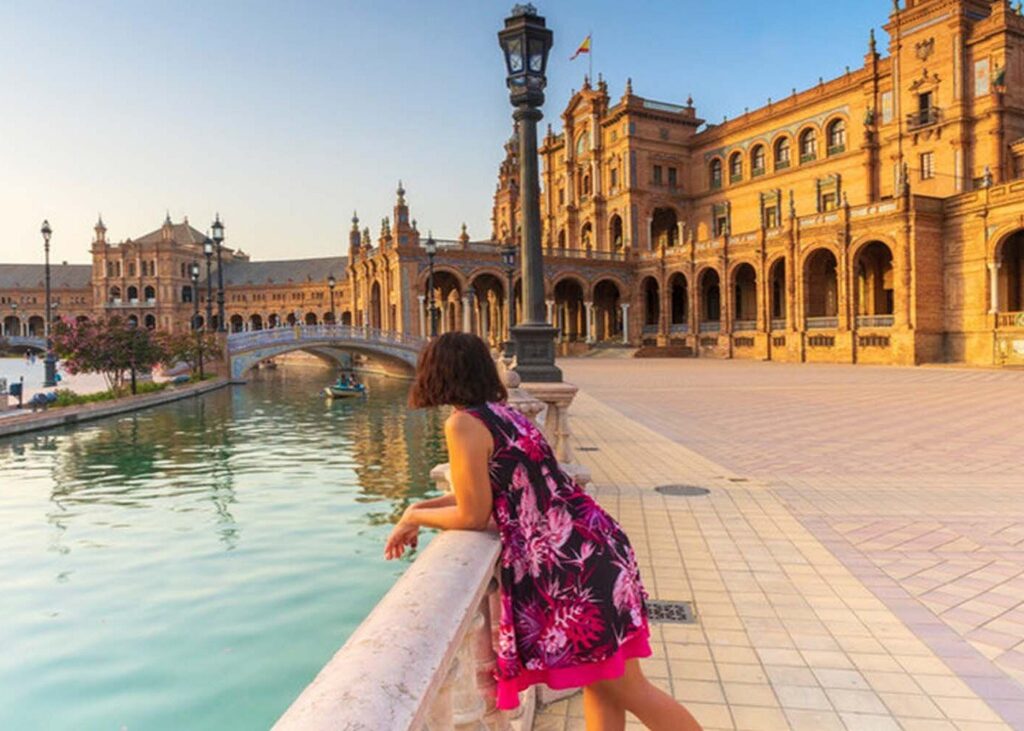
De la Redacción de Daily Passport
¿Pensas visitar España pronto? No serás el único. En 2024, este país europeo recibió un récord de 94 millones de turistas, lo que lo convirtió en el segundo país más visitado del mundo, después de Francia. Desde impresionantes palacios moriscos hasta museos de talla mundial y capitales gastronómicas, descubre ocho de nuestros lugares favoritos para visitar en España.
Parc Güell, Barcelona
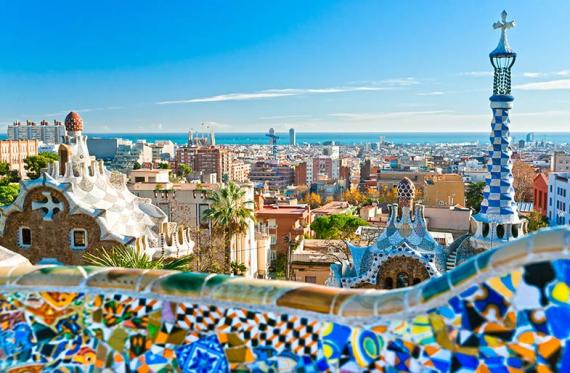
Como muchos de los sitios icónicos de Barcelona, el Park Güell fue diseñado por Antoni Gaudí, el visionario del diseño residente de la ciudad y uno de los arquitectos más famosos de España. Construida entre 1900 y 1914, la utopía urbana de 45 acres está ubicada en una ladera con vistas panorámicas de la ciudad. El área fue concebida originalmente como una subdivisión de 60 villas privadas para barceloneses adinerados, pero el vecindario nunca despegó y solo se construyeron dos estructuras: una casa modelo y la casa de un guardia. El terreno fue entregado a la ciudad y abierto como parque municipal en la década de 1920. Si bien las vistas, las plantaciones y los senderos del parque son indudablemente hermosos, lo que hace que este lugar sea realmente especial son las extravagantes instalaciones de Gaudí. Entre los aspectos más destacados se incluyen la cerca perimetral festoneada y embaldosada, un banco monumental construido para parecerse a una serpiente marina gigante e incrustado en cerámica llamativa, y una colorida escultura de salamandra en la entrada conocida como “el drac” (“el dragón”).
La terraza principal está rodeada de senderos sinuosos, viaductos curvos, jardines formales y árboles ejemplares, con un laberinto de columnas similares a palmeras que sostienen un techo de tejas amorfo. La casa modelo original del parque terminó siendo la casa familiar de Gaudí, y la villa rosa brillante ahora es un museo, otra visita obligada en un parque de la ciudad rebosante de sus maravillas. Y no te vayas de Barcelona sin visitar otro de los monumentos más famosos y perdurables de Gaudí, la (aún inacabada) Sagrada Familia, que finalmente tiene fecha de finalización.
Museo Guggenheim, Bilbao
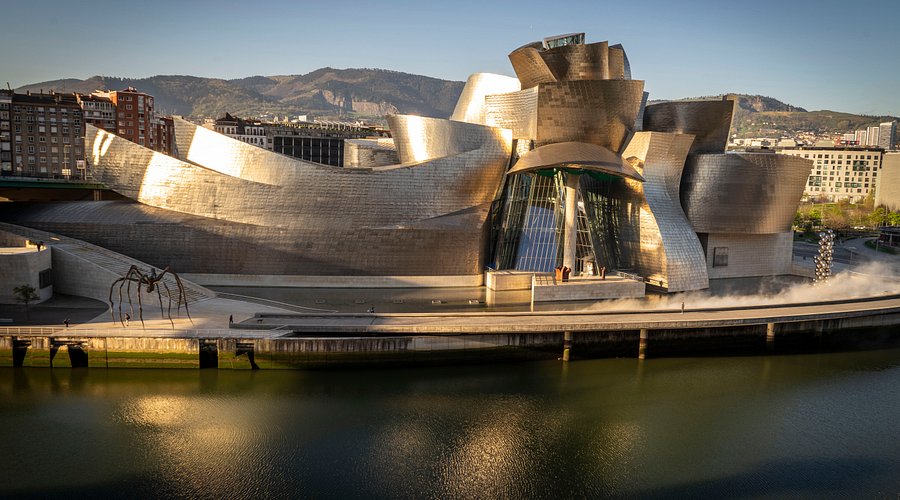
Cuando se inauguró en 1997, esta curvilínea obra maestra de titanio del arquitecto Frank Gehry quizá no haya puesto a Bilbao en el mapa —la ubicación de la ciudad sobre la ría del Nervión, cerca del Golfo de Vizcaya, ha asegurado la importancia del puerto durante siglos—, pero el museo rápidamente ejerció lo que los expertos denominaron el “Efecto Bilbao”. Se refiere a la capacidad de convertir una ciudad antaño olvidada en un atractivo turístico con una arquitectura excepcional. En el caso del Museo Guggenheim Bilbao, más de 1,3 millones de visitantes llegaron en 2024 para contemplar los famosos remolinos del museo junto al agua y sus galerías. Las colecciones permanentes incluyen importantes obras de Jenny Holzer, Richard Serra y Jeff Koons, entre muchos otros. Pero quizás la escultura más reconocible, que adorna muchas tomas del exterior del museo, es la larguirucha araña conocida como Mamá, de Louise Bourgeois.
El Acueducto Romano, Segovia
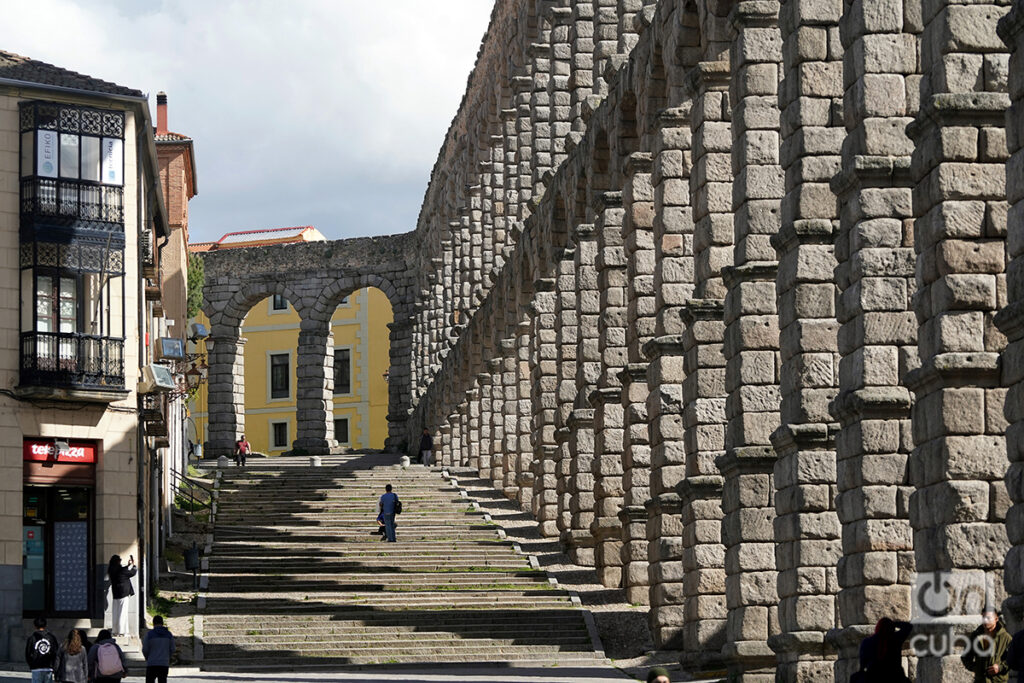
Una reliquia del Imperio Romano, el Acueducto de Segovia ha equilibrado su homónima provincia española durante casi dos milenios. Hecho de 24.000 bloques de granito y ni una onza de mortero, el acueducto (situado a una hora al norte de Madrid) todavía obtiene agua del río Frío, ubicado a 10 millas de distancia. Su sección sobre el suelo mide casi 2.400 pies de largo, extendiéndose a través de unos 165 arcos perfectamente compuestos; en algunos lugares, el acueducto se eleva más de 93 pies de altura en dos niveles de arcos. Junto con el hermoso casco antiguo de Segovia, el acueducto ha sido designado Patrimonio de la Humanidad por la UNESCO desde 1985. Si bien los historiadores estiman que el acueducto fue construido durante el reinado del emperador Trajano, en algún momento alrededor del año 50 d. C., el folclore no está de acuerdo. Según una leyenda popular, una sirvienta segoviana quería eliminar sus viajes diarios a la montaña para buscar agua, así que ofreció su alma al diablo si este lograba encontrar una alternativa para la mañana siguiente. Supuestamente, un gallo cantó justo antes de colocar el último ladrillo.
La Catedral, Sevilla
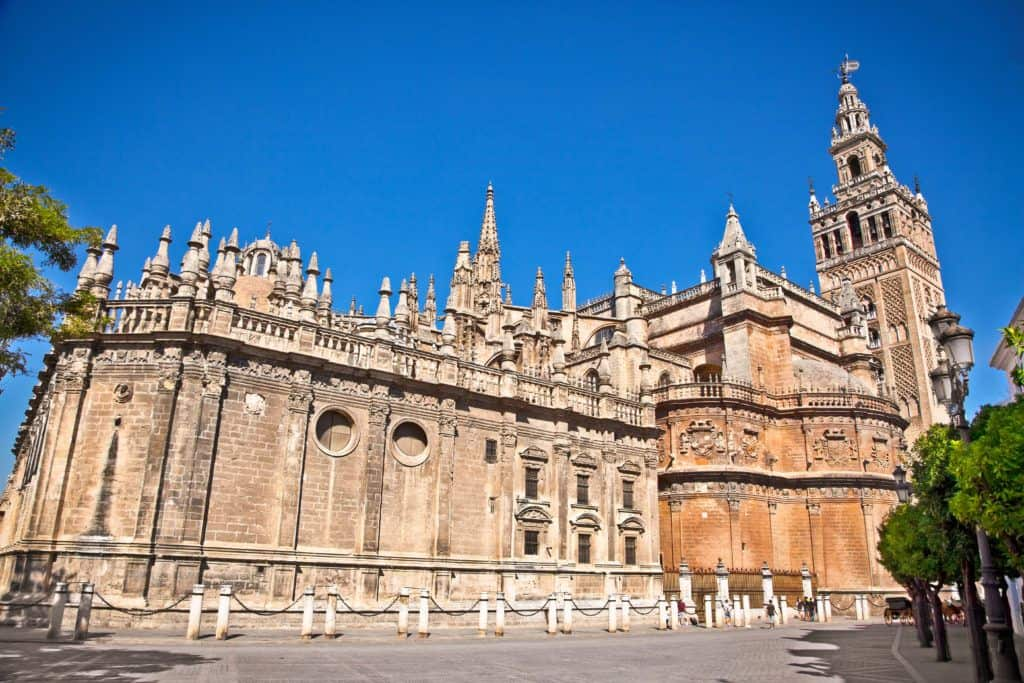
Una muestra deslumbrante de la riqueza que surgió en esta ciudad del sur de España (ahora capital de Andalucía) tras la Reconquista, la catedral de Sevilla sigue siendo el edificio gótico más grande de Europa. Tras la derrota del dominio árabe en el siglo XV, los líderes de la ciudad sevillana ordenaron la construcción de la catedral (oficialmente llamada Catedral de Santa María de la Sede) para mostrar la expansión del cristianismo por la Península Ibérica. La catedral se alza sobre una antigua mezquita y, tras su finalización en 1506, superó a Santa Sofía de Estambul como la catedral más grande del mundo. (Aunque ya no ostenta ese título, sigue siendo la tercera catedral más grande de Europa). Uno de los elementos arquitectónicos más distintivos de la catedral, un minarete de 104 metros de altura llamado Giralda, es un guiño a su antiguo propósito. Otro elemento famoso se encuentra en su interior: la catedral es también el lugar de descanso final del explorador Cristóbal Colón. Junto con el Real Alcázar de Sevilla y la antigua lonja de la ciudad, fue declarado Patrimonio de la Humanidad por la UNESCO en 1987.
San Sebastián
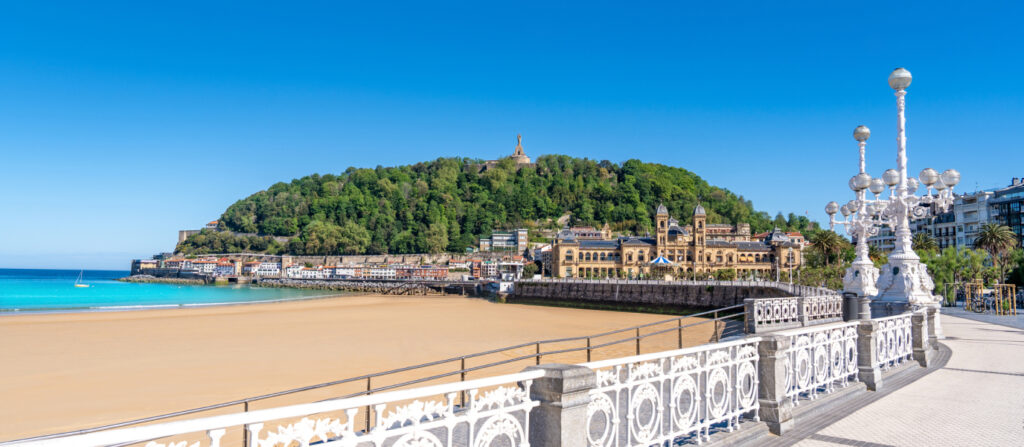
In a city of around 180,000 residents, San Sebastián’s restaurants have amassed 12 Michelin stars, as of 2025, making it one of Spain’s (and Europe’s) most exciting culinary destinations. But before this coastal city evolved into a foodie haven, this region of northern Spain’s Basque Country — known in the local Basque language as “Donostia” — served as a 13th-century seaport on the Bay of Biscay, dispatching cargo to both the Americas and greater Europe. Although the city was badly damaged in 1813 during the Peninsular War, in the following decades, Queen Isabella II adopted San Sebastián as a summer home. And it’s easy to see why: Located about 15 miles from the French border, San Sebastián’s landscape flaunts multiple coastlines — including Playa de la Concha, arguably Europe’s most exquisite urban beach — and three verdant mountain peaks: Monte Igueldo, Monte Ulia, and Monte Urgull.
El Alhambra, Granada
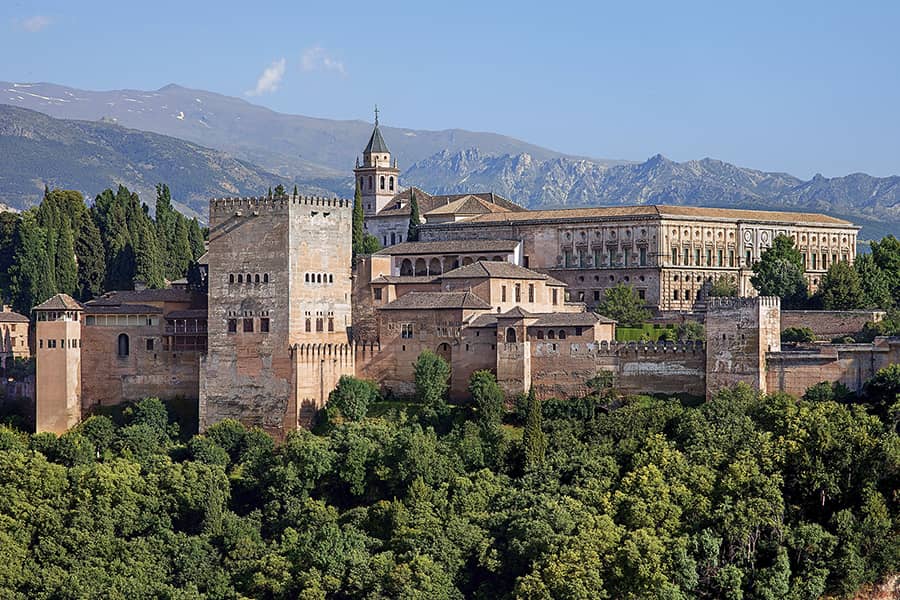
Elevándose sobre la ciudad de Granada, en la región andaluza del sur de España, se encuentra la impresionante Alhambra, cuyo nombre se traduce como “Castillo Rojo” en árabe. Llamada así por sus muros rojizos, la Alhambra se alza sobre la colina de la Sabika, junto al río Darro. La fortaleza, ahora Patrimonio de la Humanidad por la UNESCO, se ubicó estratégicamente para contemplar la ciudad y la pradera. Los primeros registros de la Alhambra datan del siglo IX, pero fue Mohammed ben Al-Hamar (Mohamed I) quien mandó construir la residencia real dentro de la fortaleza durante el siglo XIII. Hoy en día, este palacio, espectacularmente bien conservado, que cuenta con una distintiva torre de vigilancia y canales alimentados por el cercano río, recibe a más de 2,6 millones de visitantes anuales.
Museo Del Prado, Madrid
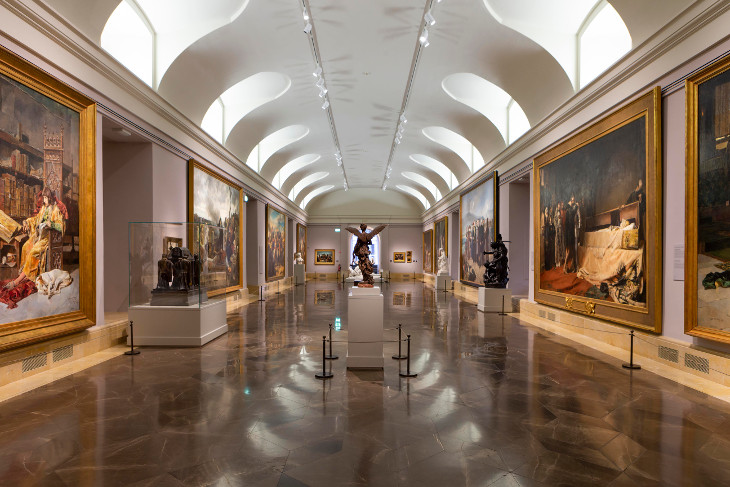
El Museo del Prado alberga la mayor colección de arte español del mundo, con obras de maestros como Picasso, El Greco y Goya. Construido en 1785, el museo fue concebido originalmente como un escaparate de historia natural, pero posteriormente el rey Fernando VII decidió convertirlo en un museo de arte. Pasó por varios cambios de nombre hasta convertirse en el Museo Nacional del Prado en 1868. El nombre significa “Museo Nacional del Prado”, en referencia a la pradera donde se construyó el museo. Alrededor de 3 millones de personas lo visitan cada año, siendo uno de los tres museos que conforman el “Triángulo de Oro” de Madrid, junto con el Reina Sofía y el Thyssen-Bornemisza.
Parque Nacional Teide, Islas Canarias
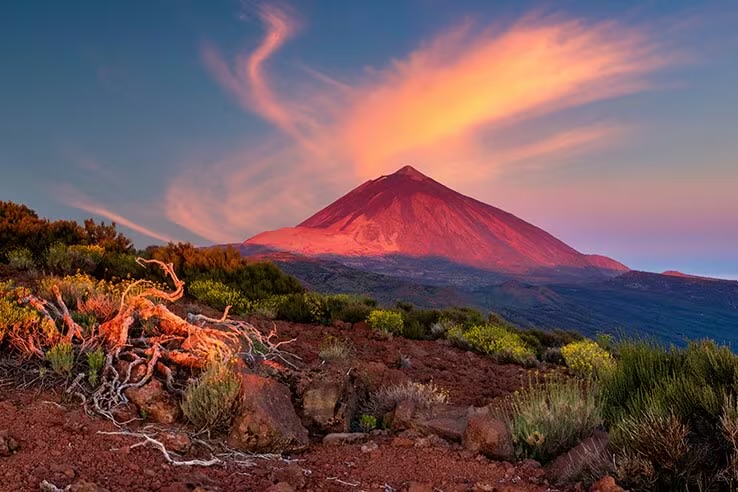
Aunque se considera el pico más alto de España, el Teide está mucho más cerca de África que de Europa. Situado a unos 320 kilómetros de la costa suroeste de Marruecos y a 1280 kilómetros al suroeste de España, este volcán, uno de los más altos del mundo, se alza casi 3680 metros desde el corazón de Tenerife, en las Islas Canarias, territorio español. El parque nacional que lo rodea, también declarado Patrimonio de la Humanidad por la UNESCO, combina rocas volcánicas con ríos de lava petrificada, chimeneas humeantes y cráteres abiertos, entre otros elementos surrealistas. Pero uno de los atractivos naturales más sobrenaturales se encuentra en el aire: de vez en cuando, un llamado “mar de nubes” se adentra en el pico, envolviéndolo con una capa adicional de dramatismo.
English version
8 of the most fascinating places in Spain
Daily Passport Team
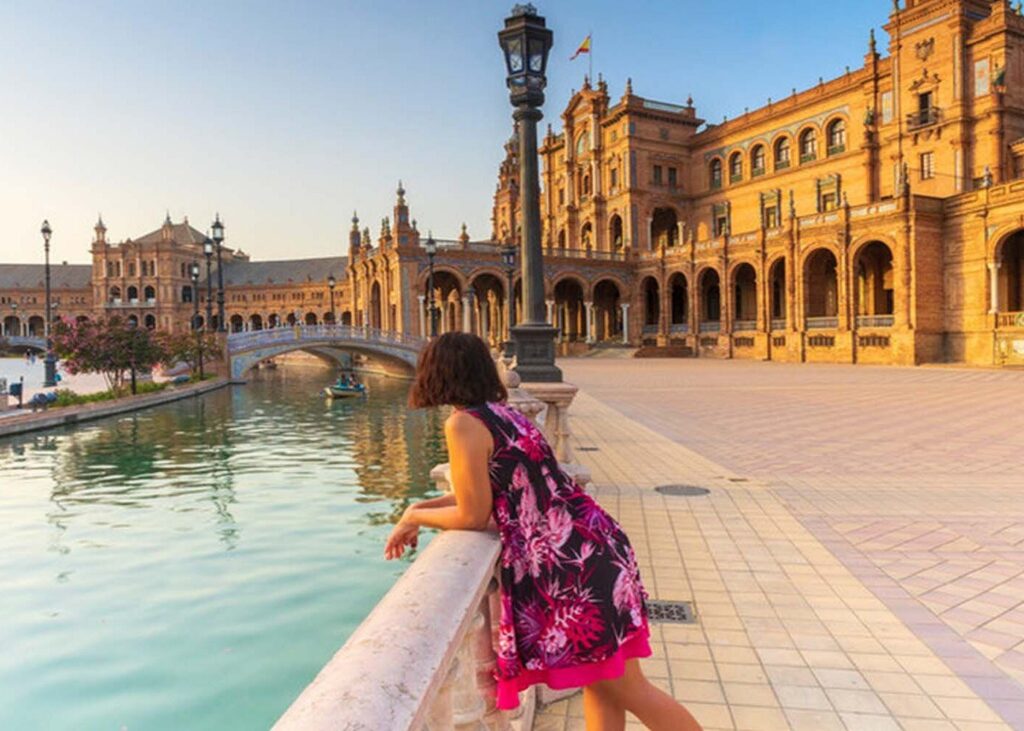
Thinking of visiting Spain soon? You won’t be alone. In 2024, the European country welcomed a record 94 million tourists — making it the second-most-visited country in the world behind France. From stunning Moorish palaces to world-class museumsand gastronomic capitals, check out eight of our favorite places to visit in Spain.
Parc Güell, Barcelona
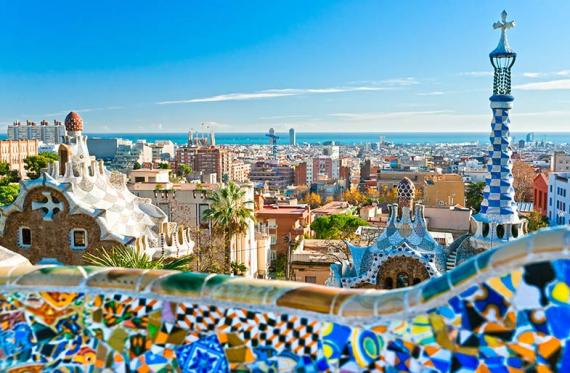
Like so many of Barcelona’s iconic sites, Park Güell was designed by Antoni Gaudí — the city’s resident design visionary and one of Spain’s most famous architects. Constructed between 1900 and 1914, the 45-acre urban utopia is located on a hillside with sweeping views of the city below. The area was originally conceived as a subdivision of 60 private villas for wealthy Barcelonians, but the neighborhood never took off, and only two structures were ever constructed — a model home and a guard’s house. The land was turned over to the city and opened as a municipal park in the 1920s. While the views, plantings, and pathways of the park are undoubtedly lovely, what makes this place truly special are Gaudí’s whimsical installations. Highlights include the scalloped and tiled perimeter fencing, a monumental bench built to resemble a giant sea serpent and encrusted in bold ceramics, and a colorful salamander sculpture at the entrance known as “el drac” (“the dragon”). The main terrace is surrounded by winding paths, curving viaducts, formal gardens, and specimen trees — with a warren of palm-like columns supporting an amorphous tiled roof. The park’s original model home ended up being Gaudí’s family home, and the bright pink villa is now a museum — another must-see in a city park brimming with his wonders. And don’t leave Barcelona without visiting another one of Gaudí’s most famous and enduring landmarks, the (still-unfinished) La Sagrada Família — which finally has a completion date.
Guggenheim Museum, Bilbao
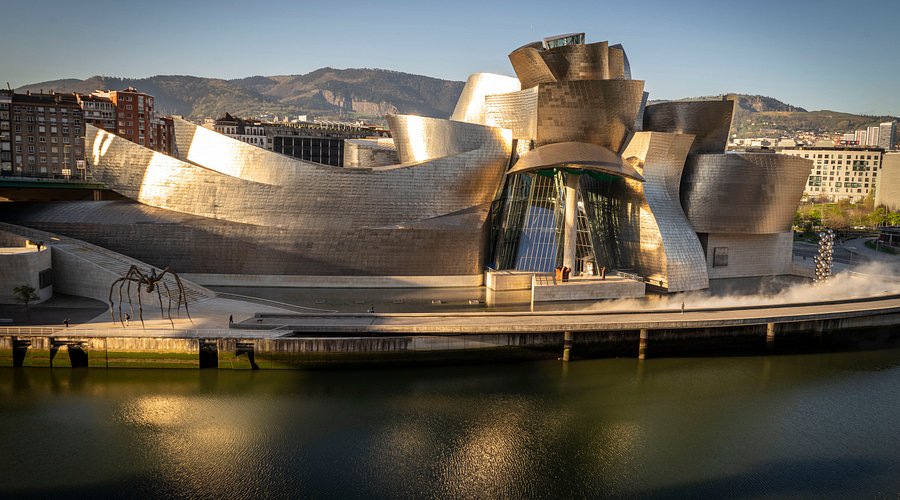
When it opened in 1997, this curvilinear titanium masterpiece by architect Frank Gehry may not have technically put Bilbao on the map — the city’s position on the Nervión River near the Bay of Biscay has assured the port’s significance for centuries — but the museum quickly exerted what experts termed “the Bilbao Effect.” It refers to the ability to turn a once-overlooked city into a tourist hotspot with trophy architecture.In the case of the Guggenheim Bilbao Museum, more than 1.3 million visitors arrived in 2024 to behold the waterside museum’s famed swirls and the galleries therein. The permanent collections include major works by Jenny Holzer, Richard Serra, and Jeff Koons, among many others. But perhaps the most recognizable sculpture, which accessorizes many a shot of the museum’s exterior, is the spindly spider known as Maman, by Louise Bourgeois.
The Roman Aqueduct, Segovia
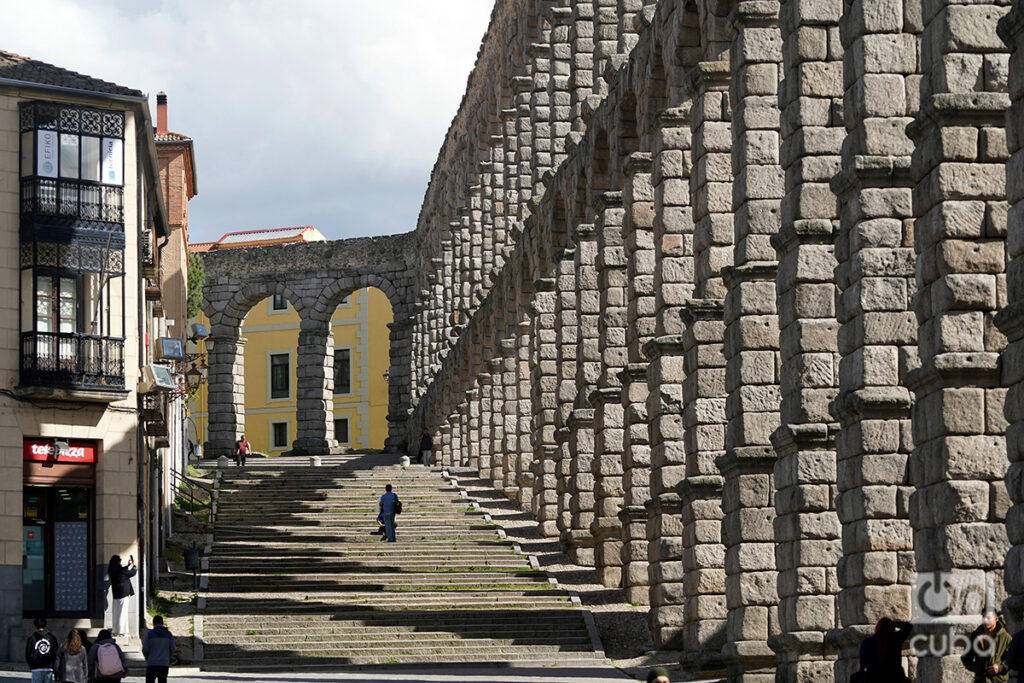
A relic of the Roman Empire, the Aqueduct of Segovia has balanced over its namesake Spanish province for nearly two millennia. Made from 24,000 granite blocks and not an ounce of mortar, the aqueduct (situated an hour north of Madrid) still fetches water from the Frío River, located 10 miles away. Its above-ground section measures almost 2,400 feet long, stretching across about 165 perfectly composed arches; in some places, the aqueduct soars more than 93 feet high in two tiers of arches. Along with Segovia’s beautiful old town, the aqueduct has been designated a UNESCO World Heritage Site since 1985. While historians estimate that the aqueduct was built during Emperor Trajan’s reign, sometime around 50 CE, folklore disagrees. According to a popular legend, a Segovian servant wanted to eliminate her daily journeys to the mountains to gather water, so she offered her soul to the devil if he could engineer an alternative by morning. Allegedly, a rooster crowed just before he put the final brick in place.
The Cathedral, Sevilla
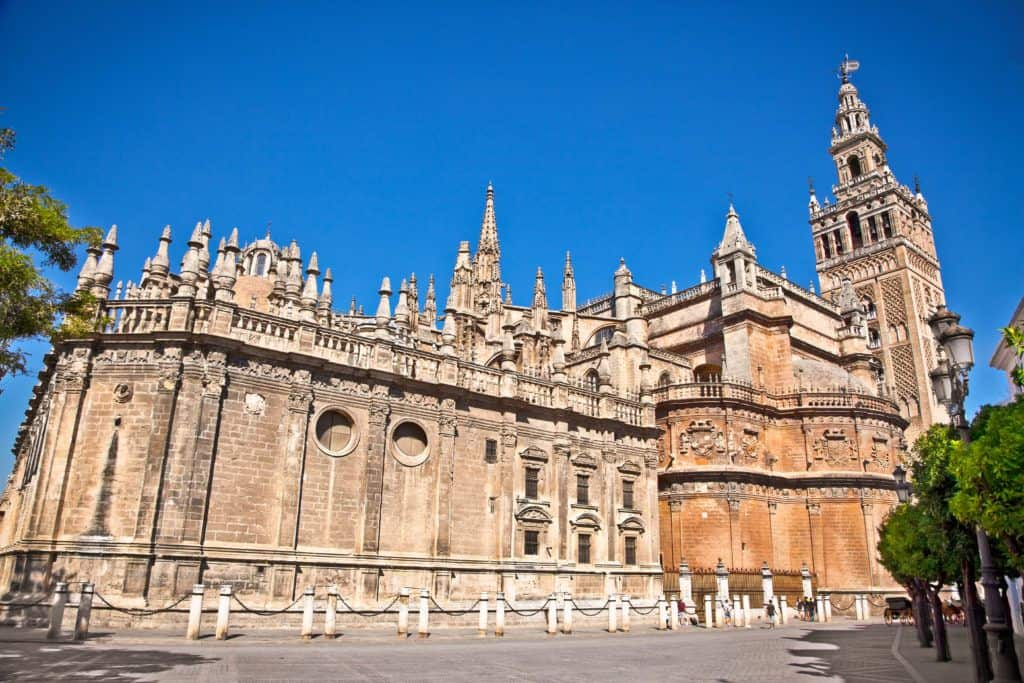
A dazzling display of the wealth that emerged in this southern Spanish city (now the capital of Andalusia) after the Reconquista years, Seville’s cathedral remains the largest Gothic building in Europe. Following the defeat of Moorish rule in the 15th century, Seville city leaders ordered the construction of the cathedral (officially named Cathedral of St. Mary of the See) to show off the expansion of Christianity throughout the Iberian Peninsula.The cathedral stands on the site of a former mosque, and upon its completion in 1506, it overtook Istanbul’s Hagia Sophia as the world’s largest cathedral. (While it no longer holds that title, it’s still the third-largest cathedral in Europe.) One of the cathedral’s most distinctive architectural features — a 343-foot-tall minaret called the Giralda — is a nod to its former purpose. Another famous feature lies deep within: The cathedral is also the final resting place of explorer Christopher Columbus. Together with Seville’s Alcázar royal palace and the city’s ancient merchant exchange, it was named a UNESCO World Heritage Site in 1987.
San Sebastián
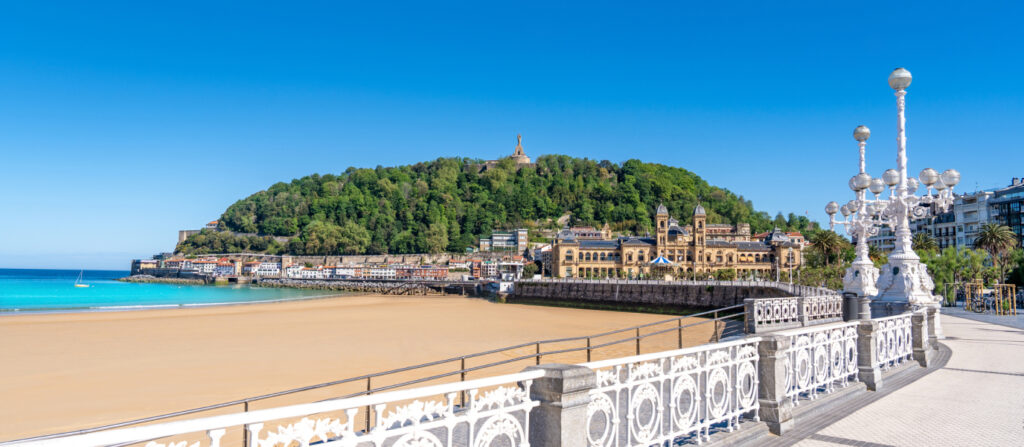
In a city of around 180,000 residents, San Sebastián’s restaurants have amassed 12 Michelin stars, as of 2025, making it one of Spain’s (and Europe’s) most exciting culinary destinations. But before this coastal city evolved into a foodie haven, this region of northern Spain’s Basque Country — known in the local Basque language as “Donostia” — served as a 13th-century seaport on the Bay of Biscay, dispatching cargo to both the Americas and greater Europe. Although the city was badly damaged in 1813 during the Peninsular War, in the following decades, Queen Isabella II adopted San Sebastián as a summer home. And it’s easy to see why: Located about 15 miles from the French border, San Sebastián’s landscape flaunts multiple coastlines — including Playa de la Concha, arguably Europe’s most exquisite urban beach — and three verdant mountain peaks: Monte Igueldo, Monte Ulia, and Monte Urgull.
The Alhambra, Granada
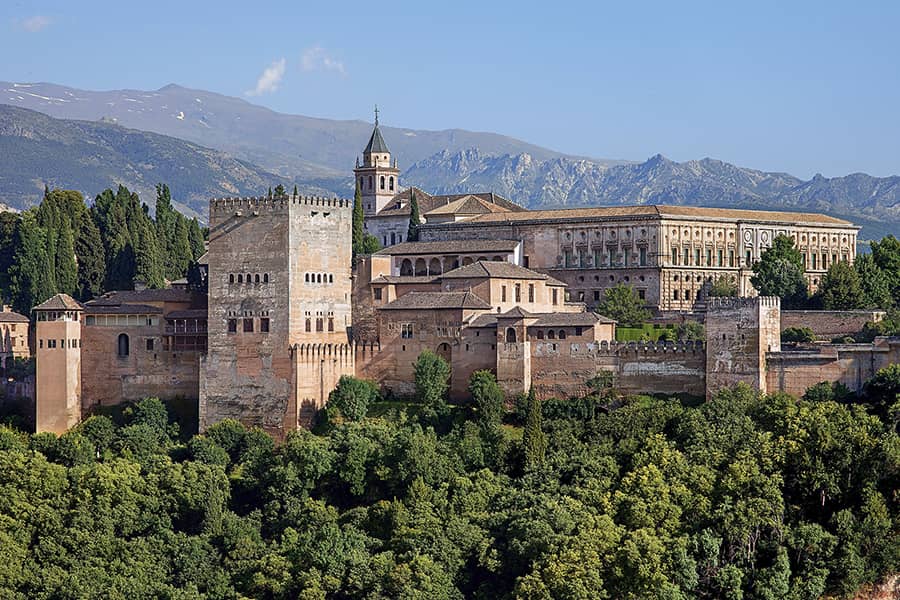
Towering above the city of Granada, in Spain’s southern Andalusia region, is the stunning Alhambra, whose name translates to “Red Castle” in Arabic. Named for its red-colored walls, Alhambra stands atop the Sabika hill alongside the Darro river. The fortress, now a UNESCO World Heritage Site, was placed there strategically to overlook the city and meadow beyond. Early records of the Alhambra date back to the ninth century, but it was Mohammed ben Al-Hamar (Mohammed I) who had the royal residence constructed within the fortress during the 13th century. Today, the spectacularly well-preserved palace, which features a distinctive watchtower and water canals fed by the nearby river, welcomes more than 2.6 million annual visitors.
Prado Museum, Madrid
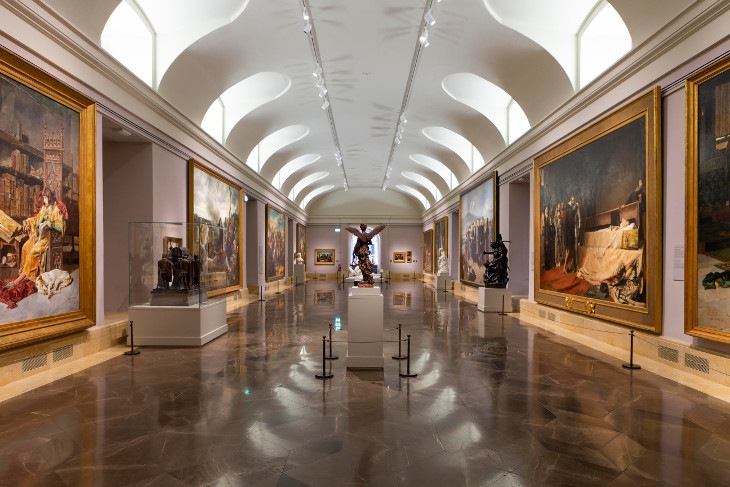
The Prado Museum is home to the world’s greatest collection of Spanish art, featuring masters like Picasso, El Greco, and Goya. The museum was built in 1785 and was originally intended to be a showcase of natural history, but King Ferdinand VII later decided to make it a museum of art. It went through several name changes, before becoming the Museo Nacional del Prado in 1868. The name translates to “National Museum of the Meadow,” a reference to the meadow on which the museum was built. Around 3 million people visit the museum each year, one of the three museums to form Madrid’s “Golden Triangle,” along with the Reina Sofía and the Thyssen-Bornemisza art museums.
Teide National Park – Canary Islands
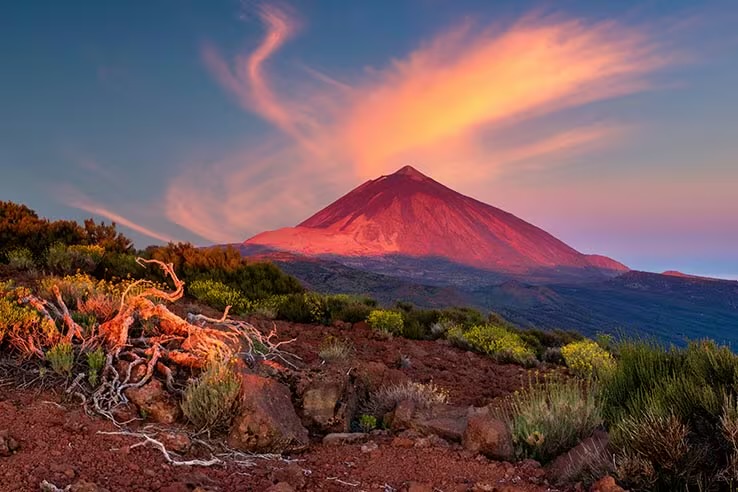
Though it’s considered Spain’s highest peak, Mount Teide is exponentially closer to Africa than to Europe. Positioned about 200 miles off the southwest coast of Morocco and 800 southwest of Spain, this volcano — one of the tallest in the world — rises almost 12,200 feet from the heart of Tenerife in the Canary Islands, a Spanish territory. The surrounding national park, also a UNESCO World Heritage Site, blends volcanic boulders with petrified lava rivers, steaming vents, and gaping craters, among other surreal elements. But one of the most otherworldly natural attractions is in the air: Every so often, a so-called “sea of clouds” moves in, enshrouding the peak in an extra layer of drama.

